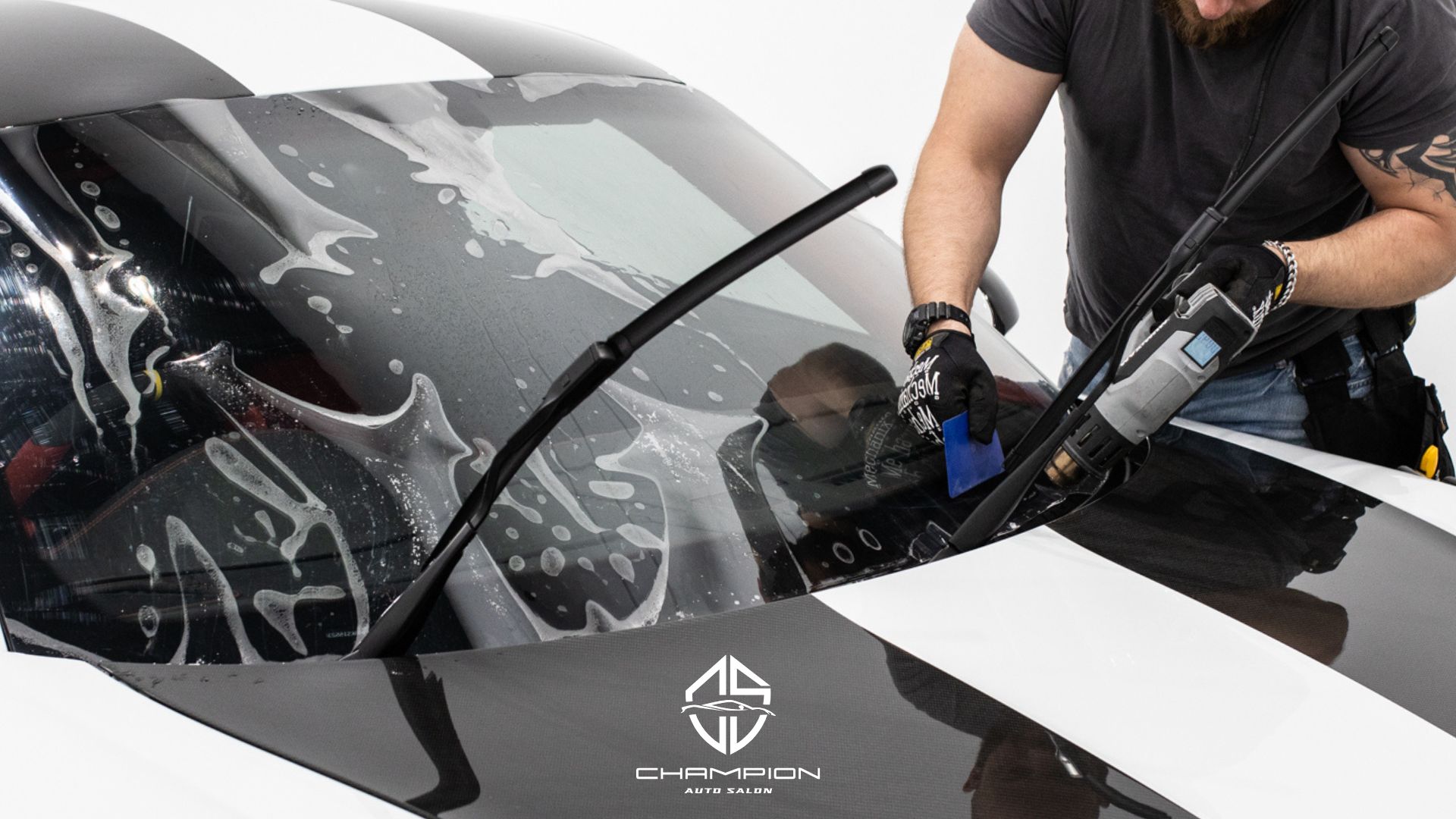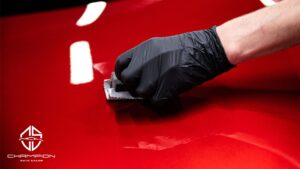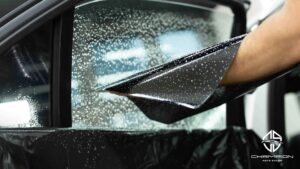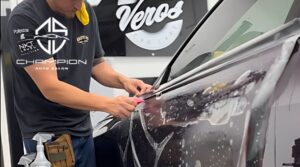If you’ve ever cruised down Ortega Highway and caught a rock to the glass… you get it. Around here, cracked windshields aren’t just a fluke — they’re part of the driving experience, whether you’re navigating I-5 during your morning commute or heading out for a weekend surf trip to Dana Point. That’s exactly why Windshield Protection Film has become such a smart investment for local drivers. At Champion Auto Salon, we’ve worked with everyone from daily commuters to adventure-seekers hitting the Cleveland National Forest — and we’ve seen firsthand how this protective layer can save your windshield (and your wallet) from unexpected damage.
What Is Windshield Protection Film?
Windshield Protection Film is a nearly invisible, ultra-durable layer applied directly to your windshield. Its job? To protect your glass from the kind of damage that’s all too common on South Orange County roads — we’re talking about rock chips, minor cracks, sand pitting, and more.
Here’s what makes it stand out:
- It’s not the same as tint — this film doesn’t darken your glass or block visibility.
- It’s different from ceramic coating, which is more about paint protection than glass.
- It’s optically clear, meaning once it’s on, you won’t even know it’s there.
- It’s 100% legal in California, when professionally installed and kept free of tints.
The best part? If something does hit your glass, the film takes the brunt of the impact — not your windshield.

Why It’s Especially Useful in San Juan Capistrano
Driving in San Juan Capistrano presents its own set of hazards. If you’ve lived here long enough, chances are you’ve experienced at least one of the following:
- Rock chips on Ortega Highway or I-5: These roads are notorious for loose gravel, especially during dry seasons or after road work. The toll roads like the 73 aren’t much better when it comes to debris at high speeds.
- Ongoing construction near Del Obispo Street: With new developments popping up and roads constantly being updated, dust and small rocks are often kicked up into traffic.
- Salt air from the coast: We love being close to the beach, but that salty breeze can wear down untreated glass over time, leading to tiny imperfections that make your windshield more vulnerable.
- Nature’s little surprises: Whether it’s pebbles from the San Juan Creek Trail, pine needles from a canyon drive, or even tree sap from parking under an oak near Los Rios Historic District — your windshield takes a beating in subtle ways every day.
That’s why more and more locals are turning to Windshield Protection Film as a preventative measure. It’s not just about protection — it’s about peace of mind every time you get behind the wheel.
How It Works: A Quick Look at the Installation Process
Installing Windshield Protection Film isn’t something you want to DIY with a roll from the internet. At Champion Auto Salon, we handle each install with care and precision — because getting it wrong can lead to peeling, bubbling, or a windshield that looks worse than before.
Here’s how the process works:
- First, we thoroughly clean and prep your windshield to make sure there’s no dust or debris.
- Then, we apply the film using professional-grade tools and heat to mold it perfectly to your glass.
- It’s cured and sealed to prevent imperfections and ensure full adhesion.
- The entire process usually takes between 1 to 2 hours, depending on your vehicle’s shape and size.
- Down the road, if you ever need it removed or replaced, the film comes off cleanly without damaging the glass underneath.
We’ve done this for daily drivers, weekend cars, and even luxury vehicles that park outside year-round — and we always tailor the install to fit your specific needs.

Key Benefits of Windshield Protection Film
When people ask us “Is it really worth it?”, we like to lay out the benefits clearly. It’s more than just a layer of plastic — it’s real protection that makes a difference.
- ✅ Chip and Crack Resistance: Say goodbye to that sinking feeling when a rock hits your glass at 70 mph.
- ✅ Enhanced Safety: If there’s an impact, the film helps hold shattered glass together, reducing the chance of flying shards.
- ✅ UV Resistance: Some high-end films provide UV blocking that helps reduce glare and cabin heat — a huge plus in Southern California.
- ✅ Cost Savings: Replacing a windshield — especially one with sensors or cameras — isn’t cheap. This film acts as your first line of defense.
- ✅ Peace of Mind: Whether you’re leasing a luxury car or just want to keep your ride in top shape, this small investment goes a long way in protecting your windshield (and your sanity).
Maintenance Tips to Get the Most Out of It
Once your Windshield Protection Film is installed, keeping it in good shape is pretty simple — just a few small habits go a long way:
- Use ammonia-free glass cleaners — harsh chemicals can weaken the adhesive over time.
- Avoid scraping ice with blades or hard tools — rare in San Juan Capistrano, but worth mentioning for the occasional chilly morning.
- Stay away from abrasive wipers or towels — soft microfiber cloths are your best bet.
- Do a quick check at every oil change — we always suggest taking a minute to inspect for signs of wear or lifting, especially after a dusty summer or a few canyon runs.
Take care of it, and your film will keep doing its job for well over a year — maybe two.
🔹 Looking for Windshield Protection Film? Champion Auto Salon provides professional windshield protection film services in San Juan Capistrano.

Is It Worth It? A Personal Take
Let me put it this way — I drive Ortega Highway at least twice a week. Between the curves, the construction trucks, and the occasional loose gravel, I’ve taken more hits to my windshield than I can count. A few months ago, a rock came flying at me on the 74 — I heard the whack, pulled over expecting the worst… and there it was: a scuff on the Windshield Protection Film, but no damage to the glass.
For anyone driving regularly in South Orange County — whether it’s your commute to Irvine, weekend beach runs, or just getting around town — this isn’t a luxury. It’s a smart protection plan that saves money and stress down the line.
🔹 Not sure which option to choose to protect your car? Contact Champion Auto Salon for expert advice.
Protect What You Drive
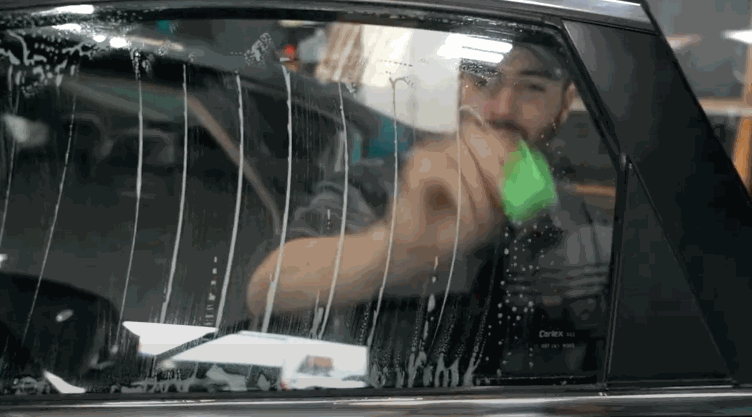
With so many local factors working against your windshield — rock chips on Ortega, salt air near Dana Point, and debris from new construction sites — Windshield Protection Film is a low-profile safeguard that makes a big difference.
Contact us today for a free quote or consultation — and let’s find the right protection for your car, right here in San Juan Capistrano.
Whether you’re a daily commuter, a weekend adventurer, or someone who just takes pride in keeping their ride in top shape, this is one of the most effective ways to protect your view of the road.
If you’re curious whether this protection makes sense for your lifestyle, swing by Champion Auto Salon — we’re locals too, and we’ll give it to you straight.
Common Questions We Get from San Juan Capistrano Drivers
Does it affect my visibility?
Not at all. Windshield Protection Film is optically clear, which means you won’t even know it’s there once it’s installed. No distortion, no tint, no glare — just protection. Many of our clients even forget it’s on until something hits their windshield and doesn’t leave a mark.
Is it legal in California?
Yes — as long as it’s installed professionally and isn’t tinted. At Champion Auto Salon, we only work with films that meet all California regulations, so you’ll stay safe, compliant, and worry-free.
Will it interfere with sensors or cameras?
This is a common concern, especially with newer vehicles. The answer? No — most modern Windshield Protection Films are fully compatible with ADAS (Advanced Driver Assistance Systems). We’ve installed film on cars with lane assist, auto-braking, heads-up displays, and more — all without issue.
How long does it last?
Typically, a high-quality Windshield Protection Film will last between 12 to 24 months, depending on how much you drive, where you park, and how well you maintain it. For most San Juan Capistrano drivers, we recommend a checkup every year — especially if your car is parked outside regularly or sees a lot of highway miles.
